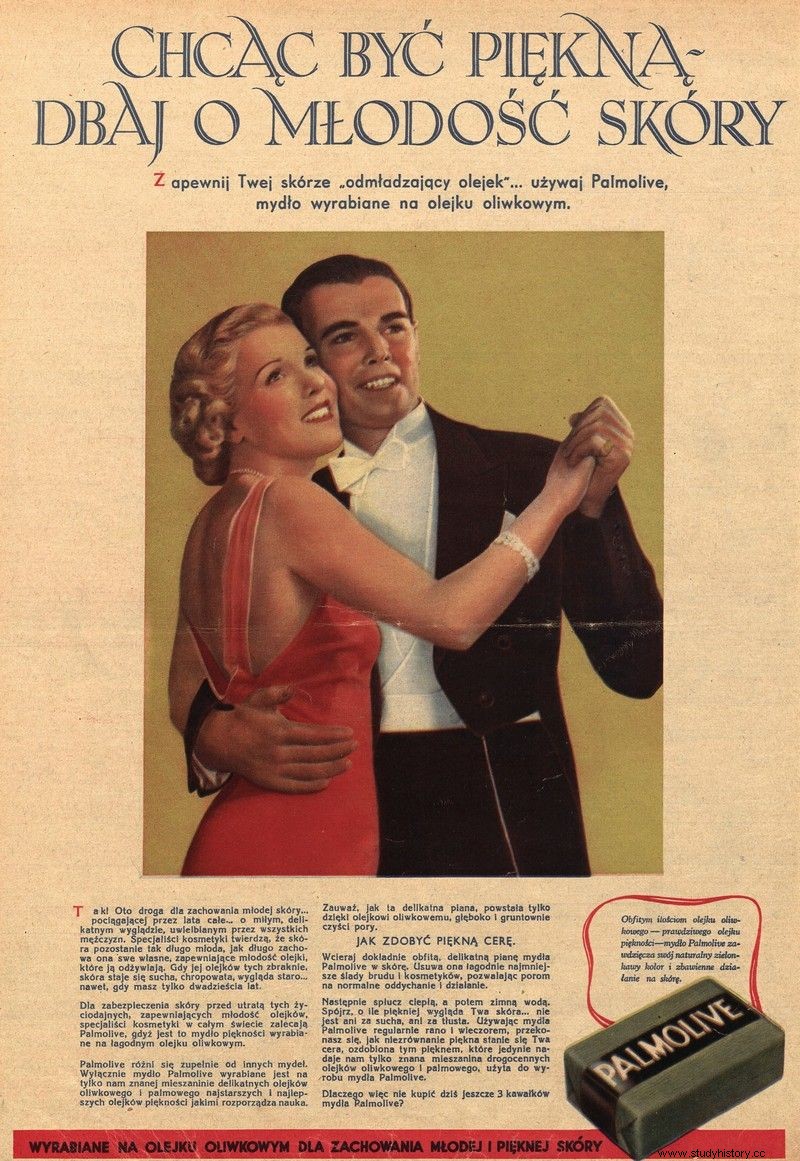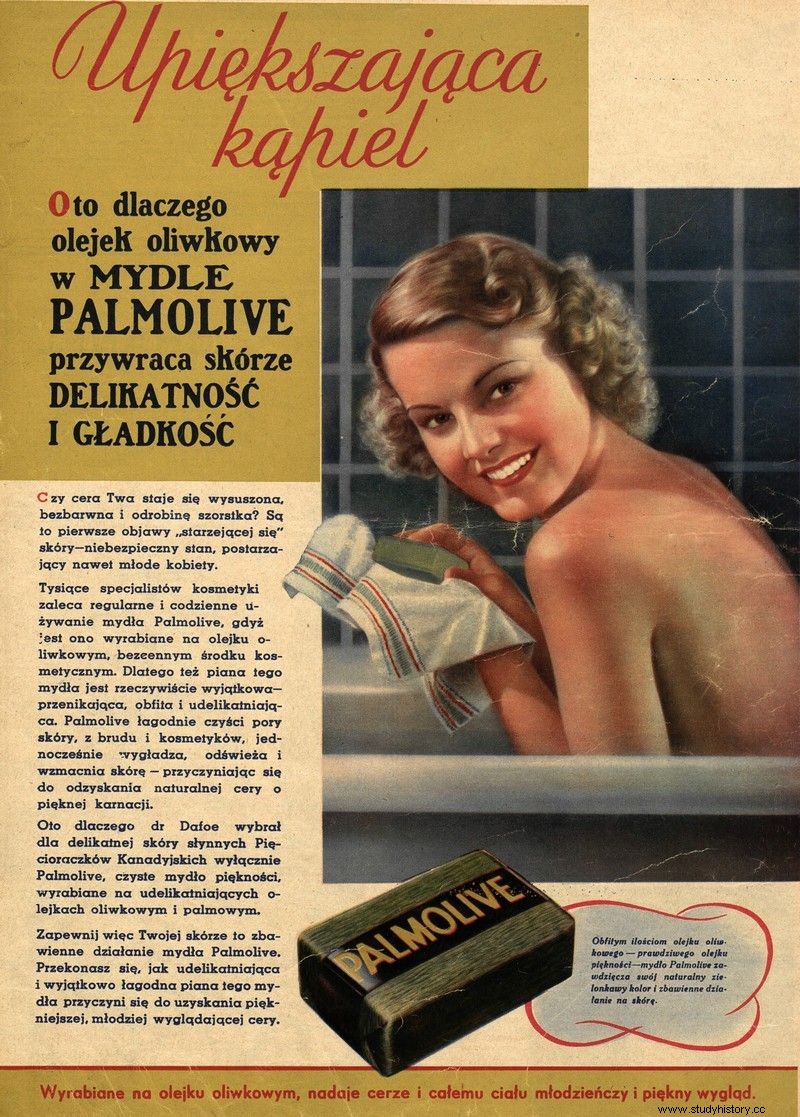b> "Recently I was washing myself at Easter, what for now is enough for Corpus Christi." According to many, this was the approach to hygiene in pre-war Poland. Fortunately, it wasn't that bad. But it wasn't easy either
In every self-respecting, pre-war house there was a special washing corner. Its obligatory equipment was a basin, a vessel for storing water (usually a jug) and soap. This is in the poor-basic version, in the countryside and in poor houses in the city. How was it with the rich?
In the 1930s, most Warsaw houses were supplied with water, sewage and electricity. The designs of new buildings took into account large, purely sanitary rooms. The bathrooms had a bathtub, sink and toilet bowl. What a progress from visiting toilets or filling the shameful vessels! In such conditions, you want to wash.
How to wash well
Unfortunately, it was different with this washing. Many women who were considered rather well-groomed were not very enthusiastic about soap and water. As a result, in the evening, the lady washed her face, hands and feet, and perfumed the rest. Why scrub when you can't see? Fortunately, such delinquents were in the minority. =
Hygiene habits were passed down from generation to generation, from mother to daughter. It was the parent, possibly in some houses vouchers, nannies and governesses who were responsible for instilling appropriate habits in the little girl.

Unfortunately, in the interwar period, many women did not share the opinion that using soap was a good idea. The picture shows a press advertisement for Palmolive soap (source:public domain).
Every morning you had to wash your face, neck, cleavage and hands in lukewarm water. Too warm water (according to old opinions) makes the body lazy and exposes the hot body to a cold, which was not difficult to find in pre-war houses. Pretty cold water was also not advisable. Not only were such morning ablutions extremely unpleasant, but they also threatened with pneumonia, a very serious disease at that time. Another variant of the morning toilet was rubbing the body with a cloth dampened in cold water.
This brisk activity essentially had three functions. First, refreshment. We wash our face with cold water in the morning. The icy stream washes away the rest of sleep, awakening the half-conscious brain in the process. Just morning coffee and the question "what are we going to do today?" you can confidently reply:"Conquer the universe!" Second, hardening. Before the war, a strong immune system was essential. That's why babies were already tempered.
They were often exposed to fresh air, in the guides we even find recommendations that they should have contact with it for three hours a day, also at low temperatures. As soon as they woke up, about two-year-olds were put in cold water for a few seconds, and after being thoroughly dried, they were made to run for a quarter of an hour in the fresh air.
And third, hygiene. Water, soap and a cloth (possibly a sponge) ... I don't think I need to explain to anyone what this set is for. Suffice it to say that the lady finished her rubbing crisp, fresh and fragrant.
You can bathe in… air
Air baths were an important medical procedure. They consisted of ... standing by the open window and breathing deeply. They were treated very seriously and recommended by many doctors. It sounds like the perfect excuse to drink coffee on the balcony.
But let's get back to the soap. This seemingly inconspicuous cosmetic was simply indispensable for our great-grandmothers. In the early twentieth century, young women were warned:you will not use soap, you will stink and you will become an old maid. Anyway, not only the little girls understood the seriousness of the situation.

When you scrub a person, it would be appropriate to use a cream.
Every woman knew that neither a pretty face, nor a beautiful body, nor a fashionable dress would help her, because the stench would scare everyone away. So the soap producers competed in inventing new types and fragrances, and the housewives prepared their own products in the privacy of their kitchens.
Among the soaps, you could find some with scary-sounding names, such as benzoin, thymol or salmon. Their use was supposed to help in everything:blackheads, pimples, redness, well! even for freckles. Some pre-war brands can also be found in modern homes, such as White Deer.
There are difficult days for a woman once a month
Perhaps the most important and most demanding for a woman is hygiene during menstruation. It was no different before the war, although women had a slightly different period then than today. Many women were malnourished or ill, often causing cycle disturbances, as well as untreated hormonal problems and female disease, as well as having large numbers of children and breastfeeding.

Menstruation or not, you need to wash yourself. And what to use for this purpose if not soap?
In magazines from that period, you can come across requests from readers to provide them with a home remedy to get rid of female ailments that may have affected the dysregulation of the body. The advice was varied, from herbal steam baths in intimate areas to the application of curdled milk orally and… externally. However, I have the impression that the effectiveness of such methods was very different. And the smell from the last treatment must have been shocking.
A separate issue was dealing with the bleeding. Today, in the first store on the corner, we will find the right hygiene products - to choose from, depending on the color. And every rural multi-sector offers several types of tampons and pads. Everything is neat, handy, disposable, fits in a pocket. In the public toilet you will find a handy rubbish bin, and in those with better supplies, even a vending machine with basic necessities for "difficult days". In a word… idyll.

Taking care of hygiene during "difficult days" caused our grandmothers and great-grandmothers a lot of trouble (source:public domain).
Our grandmothers and great-grandmothers were not so rosy. Even in the times of the People's Republic of Poland, women grabbed their purses at the words "threw cotton" and rushed with their hair blown to the nearest cotton-hygienic Eldorado. This hard-to-obtain basic necessity article released them from the need to sew sanitary napkins by hand.
And their name didn't come from keeping them below the belt ...
As for the latter, their name does not come from keeping them below the belt. In the past, during menstruation, women had to tie several straps that were supposed to hold a special insert. At the beginning of the twentieth century, women made underwear with their own hands, including the one for menstruation. It was much more complicated than the ordinary figs that are popular today.

With a scrubbed palmolive face, you can go dancing!
In addition to the supporting straps, under the needle of the lady of the house, there were also special inserts, i.e. reusable pads from more than a century ago, the length of which reached over half a meter. They were attached to the aforementioned straps, worn as much as needed, and then washed. Of course, regular washing did not kill the smell, so the authors of hygiene guides recommended boiling it (10-15 minutes in a saucepan on the kitchen did the trick).
Finally, disposable sanitary pads appeared. They are said to evolve from Benjamin Frankilln's invention to help soldiers with gunshot wounds. According to another theory, their sources were to be found in the idea of resourceful nurses who used cheap and readily available cellulose-containing bandages. Clever health workers have noticed that it is more profitable for them to use this material and throw it away immediately, than to waste time "handling" reusable sanitary pads.
Probably the American company Kotex took both of these ideas into account and began to mass-produce disposable sanitary pads. Interestingly, initially it could not advertise its product range. You can see talking about menstruation and showing hygiene products that help to survive it was too much for the morality of the time ...
